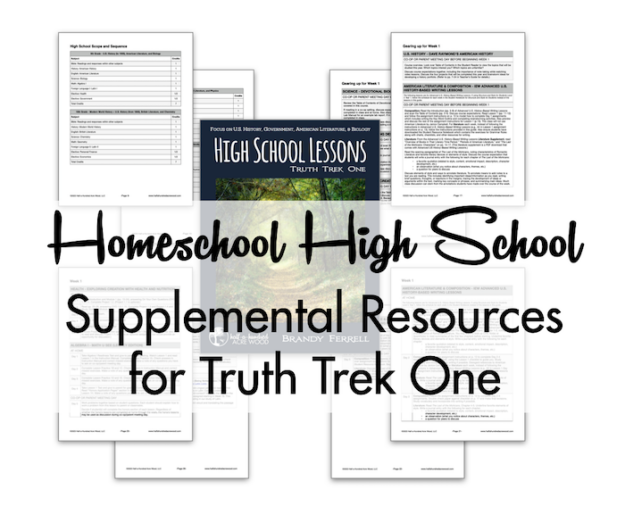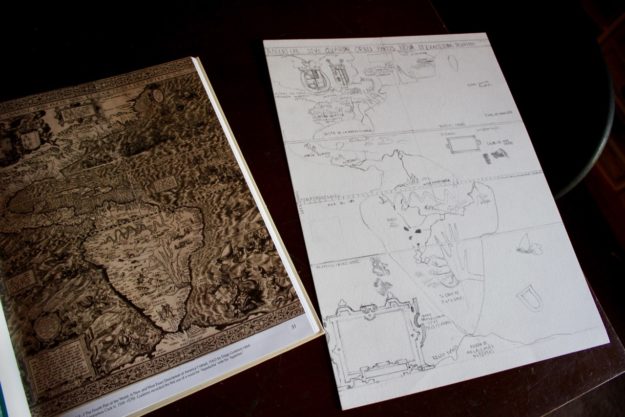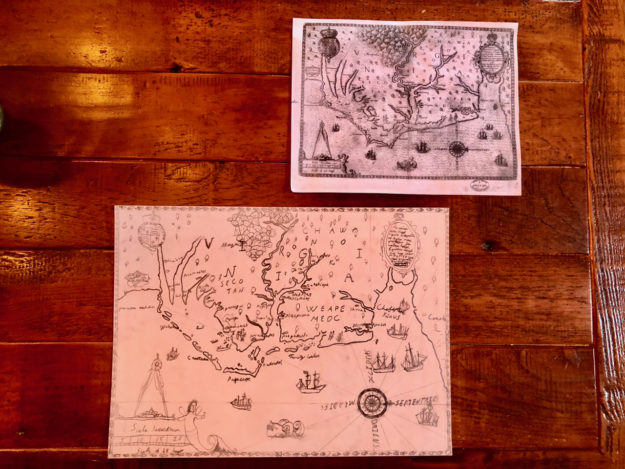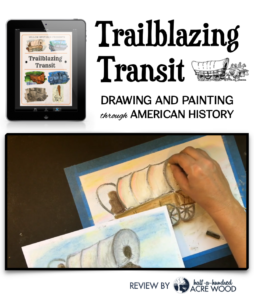
This page will be used to provide updates and supplemental resources for Half-a-Hundred Acre Wood’s Truth Trek One High School Lesson Plans. Please check back throughout the year for further updates and resources.
Truth Trek One Errata (for copies printed before April 2024). Updated 8/29/2023.
Truth Trek One Revised Edition Errata (for copies printed after April 2024). Updated 2/8/2025. The current PDF download in our store has been updated to correct these errata. Please contact us if you need the link resent to you.
You’re invited to join the Truth Trekkers Facebook Group, an online community providing support, thoughts, and ideas for families using the Truth Trek High School Lessons curriculum.
As you walk through our High School Lesson Plans, please feel free to ask questions (for any subject) if you’re needing some extra guidance or simply want to engage in discussion along the way. Praying for you all to have a great year!
Planning Resources
- Editable Transcript Template
- Crafting the Perfect Homeschool Transcript: A Step-by-Step Guide
- Article: 3 Ways to Determine My Teen’s High School Course Credit
- Physical Education Activity Log
- Resources for High School Physical Education
- Assignment/Grade Log
Science Resources
- Supplemental Resources for each chapter of Discovering Design with Biology
- Lab Supply List by Lesson for Discovering Design with Biology
- Consolidated Lab Supply List for Discovering Design with Biology
- Student Workbook for Discovering Design with Biology
- Access other resources for Discovering Design with Biology by clicking on “Product Resources”
- Click here to order lab kits for Discovering Design with Biology
- How to Write a Lab Report
Latin Resources
- The best website to help with Lingua Latina (video explanations, audio translations, quizlet flashcards, and more!)
Literature for Dave Raymond’s American History
Learning to read classics is challenging. Just as developing a habit of exercise requires *starting to exercise,* learning to read challenging literature requires *starting to read challenging literature.*
The literature that was selected for this course is meant to not only align with history, but it’s also meant to provide an overview of American literature to better equip your student to take the American Literature CLEP test at the end of the year (providing 3-6 hours of college credit). It’s tough, but it’s worth it! Almost every college degree (whether associates in business or bachelors in engineering) requires a literature course as a general education requirement. It’s better to knock it out now than to have to repeat the work later in an environment that may push ideologies you don’t want for your student(s).
Note about The Last of the Mohicans: Of all the books assigned this year, The Last of the Mohicans is the hardest to read intellectually: lots of verbose writing with grandiose words. If you choose an abridged version to just expose you/your student to the storyline, please still read at least one chapter in the original to see the style of writing (such as Chapter 19, which I think is one of the more endearing chapters).
The CliffsNotes and/or an illustrated version of The Last of the Mohicans (or other classic) will help tremendously with comprehension, especially until your student gets used to the style of writing. You can check out the Marvel Comic Illustrated version (which is available in 6 different volumes on the Libby app for library card holders), the Saddleback Illustrated Graphic Novel Version, or another picture book or abridged version of the book.
I would not want the love of learning to disappear in the midst of your homeschooling experience just because of a certain author/book. If you find that you and your child are lost in a book even while using external resources as noted above, you can instead read an abridged version to expose you to the storyline and themes. In this case, the goal is:
- Knowing the storyline, characters, and themes
- Familiarity with the style of writing (e.g., American romantic era and J. Fenimore Cooper). This will help to prepare your student to take the American lit CLEP at the end of the year.
Note about The Scarlet Letter: This book deals with the subject of adultery (albeit without details). It presents a form of “Christianity” without Christ and changed society’s views regarding the Puritans. Although it is an important literary work, we only recommend reading it with parental guidance, identifying how it misrepresents the Christian faith and the Puritans. (More historical context for the Puritans is provided via Dave Raymond’s American History to counterbalance what is presented in The Scarlet Letter.) If you would like to substitute a different work from the same era of American literature or history, feel free to do so. However, if you plan to take the American Literature CLEP test, this book is often referenced on that exam.
Literature Resources & Supplements for Dave Raymond’s American History
- The Last of the Mohicans is (in my opinion) the hardest work of literature you will read this year. I recommend using CliffsNotes or even the Marvel Comic graphic novel (which is true to the actual storyline and even uses verbiage straight from the original text) to help you walk through it.
- Chapter Summaries for The Last of the Mohicans: CliffsNotes (our preferred summaries) | Sparknotes
- “Fenimore Cooper’s Literary Offenses” by Mark Twain (for your amusement)
- Anthology of American Poetry PDF. Poetry reading for Week 28 and Week 29 and/or Week 31-36.
- Short Stories. This is a sampling of authors, in order of date. Read through as many (or as few) short stories as you like as you prepare for the American Literature CLEP test. If any of the links below are no longer working, please contact me so I can fix it for you!
- “Legend of Sleepy Hollow” and “Rip Van Winkle” by Washington Iriving
- “The Fall of the House of Usher” and “The Cask of Amontillado,” “The Purloined Letter,” or “The Tell-Tale Heart” by Edgar Allan Poe
- “Self-Reliance” by Ralph Waldo Emerson
- “Economy” or “Where I Lived and What I Lived For” from Walden by Henry David Thoreau
- “The Birth-Mark” by Nathaniel Hawthorne
- “Bartleby, the Scrivener” by Herman Melville. Also read an excerpt from Moby-Dick
- “The Open Boat” by Stephen Crane
- “To Build a Fire” by Jack London
- “A Leader of the People” from The Red Pony by John Steinbeck
- “Winter Dreams” by F. Scott Fitzgerald
- “Barn Burning” by William Faulkner
- “A Worn Path” by Eudora Welty
- “Revelation” by Flannery O’Connor
- If any of the above links are no longer working, please notify us at halfahundredacrewood @gmail.com (no spaces) so we can get them fixed for you.
- If you have the original Truth Trek Plans released in 2023, a note for Week 25: For Lesson 23 in Advanced U.S History-Based Writing Lessons, you can watch this video read-aloud of The Gardener by Sarah Stewart or this one which includes sound effects.
History Resources for Dave Raymond’s American History
The Making of a History Portfolio (blog post)
Examples of History Portfolios:
Historical Maps for Colonial Map Project:
- University of Alabama North American Maps Archive
- Early America Maps from Florida Center for Instructional Technology
- North and South American Maps from New York Public Library Digital Collections
Examples of Colonial Map Project:


Art Resources
The following are picture study packets for art appreciation.
- Native American Scenes Picture Study Packet
- Flatboats by George Caleb Bingham Picture Study Packet
- The American West by Albert Bierstadt Picture Study Packet
- Grant Wood Art Study Packet (Barns & Rural Life).
If you’d like to add online art lessons to your year, Trailblazing Transit is an optional online art course corresponding to American history. You can read our review of the program here.
Each art project is taught by professional art teacher and homeschool mom Marrissa Raimonde. In this course, students learn to draw and paint modes of transportation used over the course of U.S. history chronologically, from the time of the Native Americans up to U.S. space missions of the 20th century. Although Trailblazing Transit may be used independently, this course provides detailed instructions that correspond to the art projects as follows:
- Native American Canoe
- Lewis and Clark’s Keelboat
- Pioneer’s Wagon
- Steam Locomotive
- Ford’s Model T
- Space Shuttle
You may also want to check out Drawing Americana, Art through the Eyes of the American Woman, and/or Literature-Themed Art Courses.

